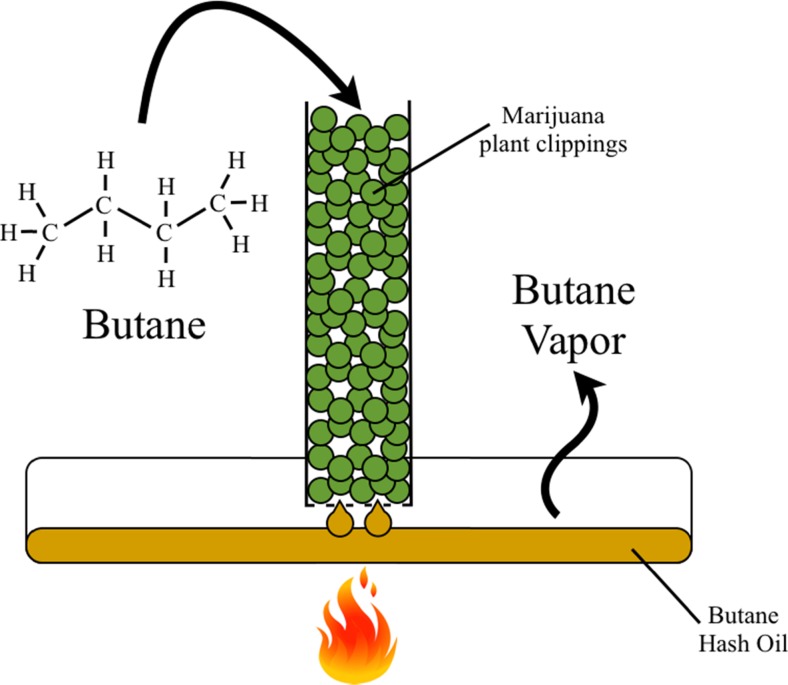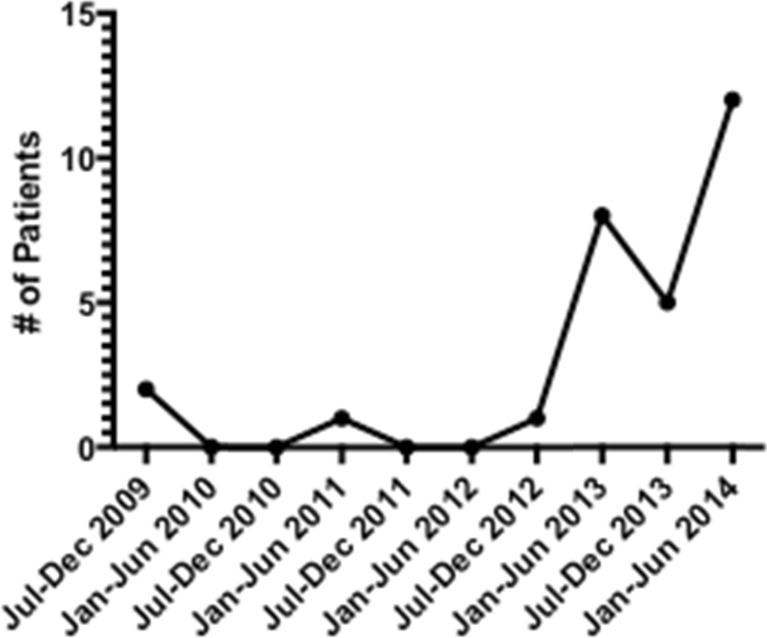Abstract
Butane hash oil (BHO), also known as “amber,” “dab,” “glass,” “honey,” “shatter,” or “wax,” is a potent marijuana concentrate, containing up to 90 % tetrahydrocannabinol (THC). BHO is easily manufactured using highly volatile butane as a solvent. Our objective was to characterize hydrocarbon burns associated with BHO manufacture in Colorado. This was a cross-sectional study utilizing the National Burn Repository to capture all hydrocarbon burns reported to the local burn center from January 1st, 2008, through August 31st, 2014. We abstracted demographic and clinical variables from medical records for patients admitted for hydrocarbon burns associated with butane hash oil extraction. Twenty-nine cases of BHO burns were admitted to the local burn center during the study period. Zero cases presented prior to medical liberalization, 19 (61.3 %) during medical liberalization (Oct 2009–Dec 2013), and 12 (38.7 %) in 2014 since legalization. The majority of cases were Caucasian (72.4 %) males (89.7 %). Median age was 26 (range 15–58). The median total-body-surface-area (TBSA) burn size was 10 % (TBSA range 1–90 %). Median length of hospital admission was 10 days. Six required intubation for airway protection (21 %). Nineteen required skin grafting, eight wound care only, one required surgical fracture repair, and one required surgical debridement. Hydrocarbon burns associated with hash oil production have increased since the liberalization of marijuana policy in Colorado. A combination of public health messaging, standardization of manufacturing processes, and worker safety regulations are needed to decrease the risks associated with BHO production.
Keywords: Burn, Butane hash oil, Colorado, Marijuana, THC
Introduction
In November of 2000, Colorado voters approved the use of medical marijuana in patients with “debilitating medical conditions” [1]. The voters subsequently amended the state constitution, which legalized the sale and use of recreational marijuana [2]. The first retail marijuana stores began selling their products to consumers, Colorado residents and visitors, over the age of 21 years on January 1st, 2014.
The liberalization of marijuana policy in Colorado has resulted in unexpected health effects including an increase in hydrocarbon burns due to butane hash oil (BHO) production [3]. BHO, also known as “honey oil,” “shatter,” “wax,” or “dab,” is a potent concentrate, which may contain more than 90 % tetrahydrocannabinol (THC) [4]. BHO is made using a hydrocarbon, most commonly butane, as a solvent to extract THC from marijuana clippings (Fig. 1). During extraction, the highly flammable and volatile butane gas permeates the air and can be easily ignited through static electricity or any other flame source.
Fig. 1.
Butane hash oil extraction apparatus. The trimmings of marijuana buds are placed into a cylinder with perforations at the bottom. A solvent, typically butane, is poured over the clippings and an extract collected in a basin. The extract is then heated at low temperature to cause evaporation of the hydrocarbon solvent leaving the THC concentrate behind
There is risk that BHO-associated burn prevalence and severity will continue to increase as users attempt to make the product in their homes and more businesses seek to manufacture it on a large scale [5]. Our objective was to characterize hydrocarbon burns associated with BHO manufacture in Colorado.
Methods
We conducted a cross-sectional study utilizing the American Burn Association’s National Burn Repository (NBR) to examine all hydrocarbon burns referred to the University of Colorado Hospital Burn Center from January 1st, 2008, through August 31st, 2014. The University of Colorado Burn Center serves the Rocky Mountain region including the entire state of Colorado and surrounding states. Patients were identified using the NBR etiology field using the search terms “explosion of gases” and “ignition of highly flammable material.” The associated comments were then searched for inclusion of BHO event description.
Medical records from unique patients with burns related to hash oil production were abstracted by JS. Those with hydrocarbon burns from other etiologies and burns from other marijuana-related activities were excluded. We captured the following variables: demographics, body surface area involved, burn depth, location of burn, length of stay, ventilator days, co-morbidities, mortality, circumstances surrounding burn, and burn treatment. Data were analyzed using JMP 10™. The study was approved by the local institutional review board.
Results
Patients
The NBR search yielded 31 visits for hydrocarbon burns associated with marijuana use during the study period. Two patients had four total visits due to re-admission after initial discharge. This resulted in 29 unique patients with BHO burns included in the study.
There were 0 cases prior to medical liberalization, 19 (61.3 %) during 3 years of medical liberalization, and 12 in 8 months of legalization (Fig. 2). The majority of cases were Caucasian (72.4 %) males (89.7 %). Median age was 26 (range 15–58). See Table 1.
Fig. 2.
Number of patients presenting with BHO burns per 6-month interval
Table 1.
Demographic/clinical variables of BHO burn cases
| Demographic/clinical variable | |
|---|---|
| Median age in years (IQR, range) | 26 (22.5, 31, 15–58) |
| Male gender, n (%) | 26 (89.7) |
| Ethnicity | |
| Hispanic, n (%) | 3 (10.3) |
| Non-Hispanic, n (%) | 24 (82.8) |
| Unknown, n (%) | 2 (6.9) |
| Race | |
| Caucasian, n (%) | 21 (72.4) |
| African American/Black, n (%) | 5 (17.2) |
| Asian, n (%) | 0 (0) |
| American Indian/Alaskan Native, n (%) | 2 (6.9) |
| Hawaiian/Pacific Islander, n (%) | 1 (3.5) |
| Median TBSA percent (IQR, range) | 10 % (4–17, 1–90) |
Clinical Characteristics of Burns
Nearly all were flash burns from explosions within an enclosed space (n = 26, 93 %). The median total body surface area (TBSA) involved was 10 % (interquartile range (IQR): 4, 17, range 1–90 %). Median length of stay was 10 days (IQR: 3, 11, range 1–53 days). Most had upper extremity (n = 27, 96 %) burns and/or burns to the head or neck (n = 19, 68 %). Six (21 %) required intubation. Nineteen required skin grafting, eight required wound care only, one required surgical fracture repair of an associated fracture/dislocation of the thumb, and one required surgical debridement. There were no deaths. A 22-year-old female suffered a 90 % TBSA burn requiring mechanical ventilation for 48 days and admission for 53 days. A 24-year-old male from the same explosion suffered 70 % TBSA, requiring ventilation for 28 days and admission for 34 days.
Discussion
The University of Colorado Burn Center experienced a dramatic increase in flash burns associated with BHO production following the liberalization of marijuana policy. Increased availability of marijuana has resulted in novel patterns of production and use associated with unforeseen health risks [3]. This same phenomenon has been seen in California [5] and should prompt policy makers of states considering liberalization to this risk. Medical marijuana liberalization and the subsequent retail marijuana legalization increased availability of the BHO; however, there were no regulations in place to limit home extraction of hash oil using hydrocarbons such as butane. Home and non-commercial extraction can be dangerous when the production rooms are poorly ventilated leading to accumulation of butane vapor.
The current market value of BHO is approximately $700 per ounce compared to approximately $200 per ounce of high-quality trimmed marijuana buds. Since marijuana buds must be trimmed to prepare them for sale, clippings are plentiful in Colorado. Many commercial growers also make butane hash oil though home extraction continues since many users still grow their own medical marijuana. However, as of July 1, 2015, Colorado House Bill 15-1305 designated home production of THC extracts illegal in the State. The financial windfall and the high concentration of THC mean the product will remain widely available in Colorado. The expense of the product at the dispensary and perceived ease of extraction entices people to make their own BHO, often in an unsafe way.
In conjunction with the Rocky Mountain High Intensity Drug Trafficking Area Program, the regional burn center has increased awareness and education about the dangers of this extraction technique. Law enforcement and first responders have been trained on BHO scene recognition to ensure safety and increase reporting. Many commercial producers now use alternative extraction techniques, such as high-pressure CO2, in lieu of butane. These methods are more expensive further contributing to persistent use of butane by smaller producers [6]. Public health messaging, increased worker safety regulations, and facility inspections are needed to decrease the risks associated with BHO production. We anticipate BHO burn injury will continue to increase as marijuana policy is liberalized across the country.
Limitations
The internal validity of this study is limited by the nature of self-reported histories and the potential for lost data with the chart review methodology. In addition, we likely missed some minor injuries that were not transferred to the burn center. This may result in a false assumption that these flash burns are more severe than the reality. It is more likely that BHO flash burns are similar to most other flash burn mechanisms. The external validity is limited by unknown patterns of BHO production in other areas outside of Colorado. There is a high likelihood of patients providing false information regarding their activities in states where BHO is illegal. Prior to the liberalization and legalization in Colorado, users may have been less likely to divulge their practice with BHO. This may result in a perceived rise in the rate of BHO burns when in fact the rise may be due to reporting bias. Producers in Colorado are more likely to discuss their activities in Colorado since the activity is not inherently illegal. In addition, the use of BHO may be increasingly independent of legalization. This increased use pattern, in addition to other underappreciated factors, may all contribute to the observed increase in BHO burn frequency.
Conclusions
In summary, marijuana policy liberalization in Colorado has been associated with an unanticipated problem of increasing hydrocarbon flash burns due to BHO production. A combination of public health messaging, standardization of manufacturing processes, and worker safety regulations are needed to decrease the risks associated with BHO production.
Acknowledgments
Dr. Monte sits on the Retail Marijuana Public Health Advisory Committee for the State of Colorado.
Sources of funding for the project
This work was supported in part by the National Institutes of Health Grants K23 GM110516 and UL1 TR000154 (AAM).
References
- 1.Colorado Constitution, Amendment 20. In: DOJ, editor. Denver, CO; 2000.
- 2.Colorado Constitution, Amendment 64. In: DOJ, editor. Denver, CO; 2012.
- 3.Monte AA, Zane RD, Heard KJ. The implications of marijuana legalization in Colorado. JAMA. 2015;313(3):241–242. doi: 10.1001/jama.2014.17057. [DOI] [PMC free article] [PubMed] [Google Scholar]
- 4.Loflin M, Earleywine M. A new method of cannabis ingestion: the dangers of dabs? Addict Behav. 2014;39(10):1430–1433. doi: 10.1016/j.addbeh.2014.05.013. [DOI] [PubMed] [Google Scholar]
- 5.Jensen G, Bertelotti R, Greenhalgh D, Palmieri T, Maguina P. Honey oil burns: a growing problem. J Burn Care Res. 2015;36(2):e34–e37. doi: 10.1097/BCR.0000000000000067. [DOI] [PubMed] [Google Scholar]
- 6.Soriano C. Dabs 2.0: CO2 extraction for cannabis concentrates. High Times. 2014 Mar 25, 2014. http://www.hightimes.com/read/dabs-20-co2-extraction-cannabis-concentrates




